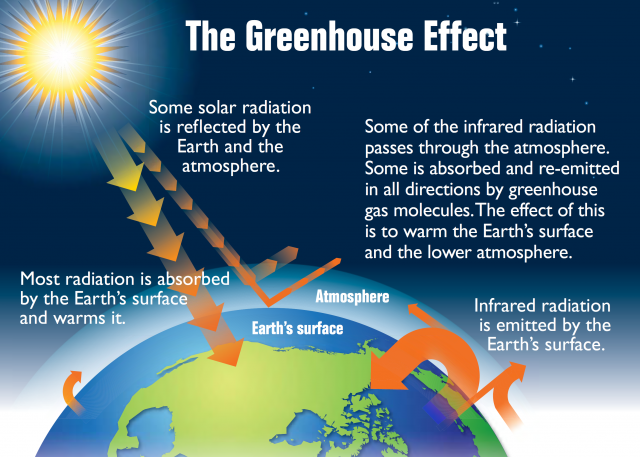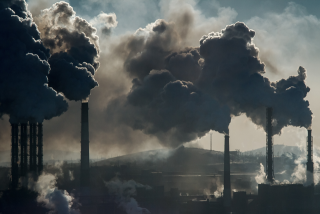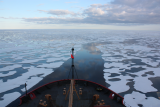How Will the Atmosphere Change as Climate Continues to Change
The earth's climate is changing. Multiple lines of evidence show changes in our weather, oceans, and ecosystems, such as:
- Changing temperature and precipitation patterns.1 2
- Increases in ocean temperatures, sea level, and acidity.
- Melting of glaciers and sea ice.3
- Changes in the frequency, intensity, and duration of extreme weather events.
- Shifts in ecosystem characteristics, like the length of the growing season, timing of flower blooms, and migration of birds.
These changes are due to a buildup of greenhouse gases in our atmosphere and the warming of the planet due to the greenhouse effect.
Atmospheric Data Trapped In Ice
Source: Smithsonian National Museum of Natural History, 2018
The Greenhouse Effect

The earth's temperature depends on the balance between energy entering and leaving the planet's system. When sunlight reaches the earth's surface, it can either be reflected back into space or absorbed by the earth. Incoming energy that is absorbed by the earth warms the planet. Once absorbed, the planet releases some of the energy back into the atmosphere as heat (also called infrared radiation). Solar energy that is reflected back to space does not warm the earth.
Certain gases in the atmosphere absorb energy, slowing or preventing the loss of heat to space. Those gases are known as "greenhouse gases." They act like a blanket, making the earth warmer than it would otherwise be. This process, commonly known as the "greenhouse effect," is natural and necessary to support life. However, the recent buildup of greenhouse gases in the atmosphere from human activities has changed the earth's climate and resulted in dangerous effects to human health and welfare and to ecosystems.
Key Greenhouse Gases
Most of the warming since 1950 has been caused by human emissions of greenhouse gases.4 Greenhouse gases come from a variety of human activities, including burning fossil fuels for heat and energy, clearing forests, fertilizing crops, storing waste in landfills, raising livestock, and producing some kinds of industrial products.
Carbon Dioxide
Carbon dioxide is the primary greenhouse gas contributing to recent climate change. Carbon dioxide enters the atmosphere through burning fossil fuels, solid waste, trees, and other biological materials, and as a result of certain chemical reactions, such as cement manufacturing. Carbon dioxide is absorbed and emitted naturally as part of the carbon cycle, through plant and animal respiration, volcanic eruptions, and ocean-atmosphere exchange.
Source: Smithsonian National Museum of Natural History, May 30, 2019
Methane
Both natural and human activities produce methane. For example, natural wetlands, agricultural activities, and fossil fuel extraction and transport all emit methane.
Nitrous Oxide
Nitrous oxide is produced mainly through agricultural activities and natural biological processes. Fossil fuel burning and industrial processes also create nitrous oxide.
F-Gases
Chlorofluorocarbons, hydrochlorofluorocarbons, hydrofluorocarbons, perfluorocarbons, and sulfur hexafluoride, together called F-gases, are often used in coolants, foaming agents, fire extinguishers, solvents, pesticides, and aerosol propellants.
Other Greenhouse Gases
Ground-Level Ozone
Ground-level ozone is created by a chemical reaction between emissions of nitrogen oxides and volatile organic compounds from automobiles, power plants, and other industrial and commercial sources in the presence of sunlight. In addition to trapping heat, ground-level ozone is a pollutant that can cause respiratory health problems and damage crops and ecosystems.
Water Vapor
Water vapor is another greenhouse gas and plays a key role in climate feedbacks because of its heat-trapping ability. Warmer air holds more moisture than cooler air. Therefore, as greenhouse gas concentrations increase and global temperatures rise, the total amount of water vapor in the atmosphere also increases, further amplifying the warming effect.5
For more information on greenhouse gases, see Greenhouse Gas Emissions.
Aerosols

Aerosols in the atmosphere can affect climate. Aerosols are microscopic (solid or liquid) particles that are so small that instead of quickly falling to the surface like larger particles, they remain suspended in the air for days to weeks. Human activities, such as burning fossil fuels and biomass, contribute to emissions of these substances, although some aerosols also come from natural sources such as volcanoes and marine plankton.
Unlike greenhouse gases, the climate effects of aerosols vary depending on what they are made of and where they are emitted. Depending on their color and other factors, aerosols can either absorb or reflect sunlight. Aerosols that reflect sunlight, such as particles from volcanic eruptions or sulfur emissions from burning coal, have a cooling effect. Those that absorb sunlight, such as black carbon (a part of soot), have a warming effect.
Not only can black carbon directly absorb incoming and reflected sunlight, but it can also absorb infrared radiation.6 Black carbon can also be deposited on snow and ice, darkening the surface and thereby increasing the snow's absorption of sunlight and accelerating melt.7 While reductions in all aerosols can lead to more warming, targeted reductions in black carbon emissions can reduce global warming. Warming and cooling aerosols can also interact with clouds, changing their ability to form and dissipate, as well as their reflectivity and precipitation rates. Clouds can contribute both to cooling, by reflecting sunlight, and warming, by trapping outgoing heat.
Climate Feedbacks
Climate feedbacks are natural processes that respond to global warming by offsetting or further increasing change in the climate system. Feedbacks that offset the change in climate are called negative feedbacks. Feedbacks that amplify changes are called positive feedbacks.

Water vapor appears to cause the most important positive feedback. As the earth warms, the rate of evaporation and the amount of water vapor in the air both increase. Because water vapor is a greenhouse gas, this leads to further warming.

The melting of Arctic sea ice is another example of a positive climate feedback. As temperatures rise, sea ice retreats. The loss of ice exposes the underlying sea surface, which is darker and absorbs more sunlight than ice, increasing the total amount of warming. Less snow cover during warm winters has a similar effect.

Clouds can have both warming and cooling effects on climate. They cool the planet by reflecting sunlight during the day, and they warm the planet by slowing the escape of heat to space (this is most apparent at night, as cloudy nights are usually warmer than clear nights).
Climate change can lead to changes in the coverage, altitude, and reflectivity of clouds. These changes can then either amplify (positive feedback) or dampen (negative feedback) the original change. The net effect of these changes is likely an amplifying, or positive, feedback due mainly to increasing altitude of high clouds in the tropics, which makes them better able to trap heat, and reductions in coverage of lower-level clouds in the mid-latitudes, which reduces the amount of sunlight they reflect. The magnitude of this feedback is uncertain due to the complex nature of cloud/climate interactions.8
1Vose, R.S., D.R. Easterling, K.E. Kunkel, A.N. LeGrande & M.F. Wehne. (2017). Temperature changes in the United States. In: Climate science special report: Fourth national climate assessment, volume I [Wuebbles, D.J., D.W. Fahey, K.A. Hibbard, D.J. Dokken, B.C. Stewart & T.K. Maycock (eds.)]. U.S. Global Change Research Program, Washington, DC, pp. 197–199. doi: 10.7930/J0N29V45
2IPCC (2013).Climate change 2013: The physical science basis.Working Groups I, II and III contribution to the fifth assessment report of the Intergovernmental Panel on Climate Change [Stocker, T.F., D. Qin, G.-K. Plattner, M. Tignor, S.K. Allen, J. Boschung, A. Nauels, Y. Xia, V. Bex & P.M. Midgley (eds.)]. Cambridge University Press, Cambridge, United Kingdom and New York, NY, pp. 187–189 and pp. 201–208.
3Hayhoe, K., D.J. Wuebbles, D.R. Easterling, D.W. Fahey, S. Doherty, J. Kossin, W. Sweet, R. Vose & M. Wehner. (2018). Our changing climate. In: Impacts, risks, and adaptation in the United States: Fourth national climate assessment, volume II [Reidmiller, D.R., C.W. Avery, D.R. Easterling, K.E. Kunkel, K.L.M. Lewis, T.K. Maycock & B.C. Stewart (eds.)]. U.S. Global Change Research Program, Washington, DC, pp. 91–94. doi: 10.7930/NCA4.2018.CH2
4National Academy of Sciences. (2020). Climate change: evidence and causes: Update 2020. The National Academies Press, Washington, DC, p 5. doi: 10.17226/25733
Wuebbles, D.J., D.W. Fahey, K.A. Hibbard, B. DeAngelo, S. Doherty, K. Hayhoe, R. Horton, J.P. Kossin, P.C. Taylor, A.M. Waple, and C.P. Weaver. (2017). Executive summary. In: Climate science special report: Fourth national climate assessment, volume I [Wuebbles, D.J., D.W. Fahey, K.A. Hibbard, D.J. Dokken, B.C. Stewart, & T.K. Maycock (eds.)]. U.S. Global Change Research Program, Washington, DC, p. 14. doi: 10.7930/J0DJ5CTG
5 Wuebbles, D.J., D.R. Easterling, K. Hayhoe, T. Knutson, R.E. Kopp, J.P. Kossin, K.E. Kunkel, A.N. LeGrande, C. Mears, W.V. Sweet, P.C. Taylor, R.S. Vose & M.F. Wehner. (2017). Our globally changing climate. In: Climate science special report: Fourth national climate assessment, volume I [Wuebbles, D.J., D.W. Fahey, K.A. Hibbard, D.J. Dokken, B.C. Stewart, and T.K. Maycock (eds.)]. U.S. Global Change Research Program, Washington, DC, pp. 35-72. doi: 10.7930/J08S4N35
6 Myhre, G., D. Shindell, F.-M. Bréon, W. Collins, J. Fuglestvedt, J. Huang, D. Koch, J.-F. Lamarque, D. Lee, B. Mendoza, T. Nakajima, A. Robock, G. Stephens, T. Takemura & H. Zhang. (2013). Anthropogenic and natural radiative forcing. In: Climate change 2013: The physical science basis. Working Group I contribution to the fifth assessment report of the Intergovernmental Panel on Climate Change [Stocker, T.F., D. Qin, G.-K. Plattner, M. Tignor, S.K. Allen, J. Boschung, A. Nauels, Y. Xia, V. Bex and P.M. Midgley (eds.)]. Cambridge University Press, Cambridge, United Kingdom, and New York, NY, p. 685.
7 Myhre, G., D. Shindell, F.-M. Bréon, W. Collins, J. Fuglestvedt, J. Huang, D. Koch, J.-F. Lamarque, D. Lee, B. Mendoza, T. Nakajima, A. Robock, G. Stephens, T. Takemura & H. Zhang. (2013). Anthropogenic and natural radiative forcing. In: Climate change 2013: The physical science basis. Working Group I contribution to the fifth assessment report of the Intergovernmental Panel on Climate Change [Stocker, T.F., D. Qin, G.-K. Plattner, M. Tignor, S.K. Allen, J. Boschung, A. Nauels, Y. Xia, V. Bex and P.M. Midgley (eds.)]. Cambridge University Press, Cambridge, United Kingdom, and New York, NY, p. 685.
8 IPCC. (2013). Climate change 2013: The physical science basis.Working Group I contribution to the fifth assessment report of the Intergovernmental Panel on Climate Change [Stocker, T.F., D. Qin, G.-K. Plattner, M. Tignor, S.K. Allen, J. Boschung, A. Nauels, Y. Xia, V. Bex & P.M. Midgley (eds.)]. Cambridge University Press, Cambridge, United Kingdom, and New York, NY, p. 593.
Source: https://www.epa.gov/climatechange-science/basics-climate-change